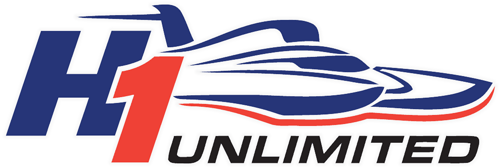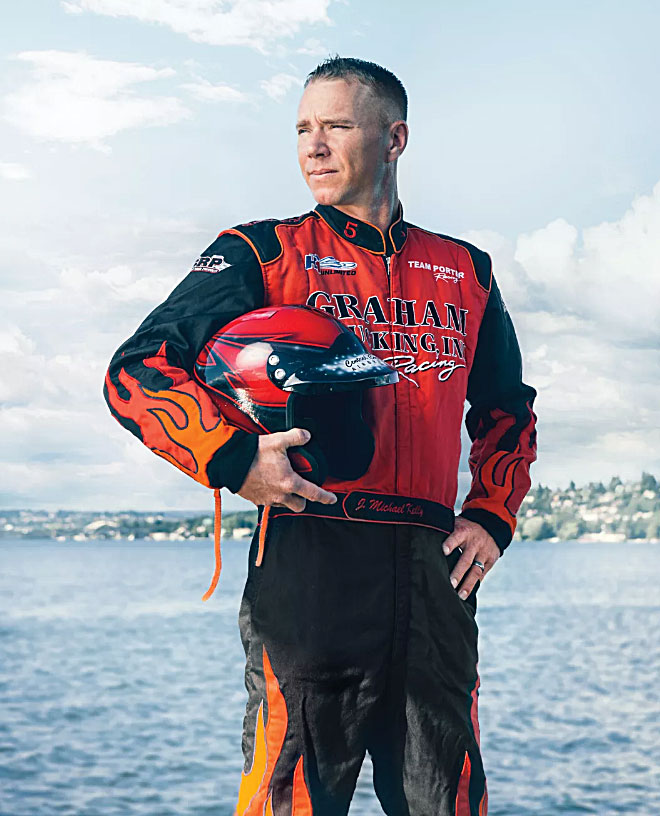J. Michael Kelly Just Wants to Run a Clean Race
Courtesy Seattle Met
J. MICHAEL KELLY IS THE two-time defending champion of Seafair’s Albert Lee Cup, but both wins were clouded by controversy. In 2014, his Graham Trucking boat was out of Lake Washington long before judges decided not to penalize him for pushing another boat out of his way. One year later he benefitted from a one-minute penalty slapped on Jimmy Shane, who’d bumped Kelly on the way to crossing the finish line first. This year the 37-year-old Bonney Lake native would like to take the cup on August 7 without having to wait for a decision. Because when you’re used to driving 200 miles an hour, sitting around can be a real drag. —Matthew Halverson
The J is short for Jeffrey. I’m a junior, so growing up it was easier to call me Mike. When I started racing, my dad just wrote down “J. Michael” on an entry form one day, and it kind of stuck ever since.
I’m a third-generation racer. My grandfather and my great uncles all started racing a long time ago. I remember going to Green Lake when I was probably three or four, sitting in a lawn chair on the beach and watching my dad race. I was always excited to get up early in the morning, get in the van, hook up the trailer, and head to the boat races.
I got to race a boat for the first time when I turned nine. I was running what they call a J-Stock hydroplane. I think my top speed was around 25 miles an hour. I’d watched races from the shoreline, so I knew exactly what you had to do. But once I got in the boat, it all kind of left me. It was scary at first.
What I run now is an unlimited hydroplane. You’ve got a five-point harness, you’ve got an air mask and are on full-time air, and you hit speeds up to 200 miles per hour on the water. Mine runs two 57-turbine helicopter engines for power, and they put out about 3,000 horsepower.
You’re out there getting bounced around, and the g-forces that you take going through the corners are extreme. I mean, you go into turns and you’re basically getting slammed to the right and trying to hold your head up. It takes a lot of work to get those things around the racecourse. By the time you get out of there, you’re physically drained.
You have to stay focused because there’s no room for error. You’ve got a split second to make a decision and go where you need to go. Because if you don’t, bad things can happen. When you’re going that fast, things happen really quick.
My worst accident was 1999 in Bakersfield, California. I was racing in a class that’s called C-Stock hydro. They run speeds up to about 65, 70 miles an hour. I ended up kind of blowing over, but I landed right side up, facing the oncoming boats. And I got run over by another boat, head on. I ended up getting my hand cut up, and I got hit hard enough that it tore my liver. They had to medi-fly me out of there.
I thought my name was Steve when I got to the hospital. A couple of the other competitors had gone by to see if I was okay, and I remember looking at the boats thinking, “Why am I in the water, and what are those things?” So these things I’d grown up my whole life watching, I didn’t even know what they were.
I’ll spend hours throughout the race day sitting in the truck and going over timing marks. Before the race starts, I’ll come up with three or four different options for where I need to be on the course at a certain time to get myself in the best position I can. Sometimes I’ll have to go with Plan C because where I wanted to be, there’s already a boat.
When Jimmy bumped me last year, it was a pretty good jolt. It hooked the boat to the left, and then I had to fight it from hitting the buoys. It was pretty violent. It doesn’t really look like it, because the boats are 30 feet long, 15 feet wide, and weigh 6,500 pounds. They take quite a bit. But I definitely felt it and lost a ton of momentum when that happened.
Sometimes drivers butt heads, but we still get along. Last weekend I raced against Jimmy Shane in the smaller inboard classes over in Richland, and we ran deck to deck. Afterward we were staying at the same hotel and took the kids down to the pool and let them swim together. You have to be able to do that or you’re not going to enjoy the racing as much.
I have a day job. I’m a finish carpenter. Back in the early ’90s, Chip Hanauer, Dave Villwock, and those guys, they did this for a living. They were making a lot of money. Over time, though, we’ve lost some race sites. Like last year, we only had five races. It takes a lot of effort to put on these events.
I have three boys. I have a stepson who’s 17, and then I’ve got a seven-year-old and a newborn. My seven-year-old is all about going to the boat races. He gets to meet a lot of the fans too. When we go to do autograph sessions, he pulls up a chair and climbs right in there and wants to sign autographs too. He’s already itching to get a boat and go racing. I keep on telling him he has to wait two more years, and he’s like, “I can do it now.”
The first step to winning is getting a good start.
J. Michael Kelly Just Wants to Run a Clean Race
Courtesy Seattle Met
J. MICHAEL KELLY IS THE two-time defending champion of Seafair’s Albert Lee Cup, but both wins were clouded by controversy. In 2014, his Graham Trucking boat was out of Lake Washington long before judges decided not to penalize him for pushing another boat out of his way. One year later he benefitted from a one-minute penalty slapped on Jimmy Shane, who’d bumped Kelly on the way to crossing the finish line first. This year the 37-year-old Bonney Lake native would like to take the cup on August 7 without having to wait for a decision. Because when you’re used to driving 200 miles an hour, sitting around can be a real drag. —Matthew Halverson
The J is short for Jeffrey. I’m a junior, so growing up it was easier to call me Mike. When I started racing, my dad just wrote down “J. Michael” on an entry form one day, and it kind of stuck ever since.
I’m a third-generation racer. My grandfather and my great uncles all started racing a long time ago. I remember going to Green Lake when I was probably three or four, sitting in a lawn chair on the beach and watching my dad race. I was always excited to get up early in the morning, get in the van, hook up the trailer, and head to the boat races.
I got to race a boat for the first time when I turned nine. I was running what they call a J-Stock hydroplane. I think my top speed was around 25 miles an hour. I’d watched races from the shoreline, so I knew exactly what you had to do. But once I got in the boat, it all kind of left me. It was scary at first.
What I run now is an unlimited hydroplane. You’ve got a five-point harness, you’ve got an air mask and are on full-time air, and you hit speeds up to 200 miles per hour on the water. Mine runs two 57-turbine helicopter engines for power, and they put out about 3,000 horsepower.
You’re out there getting bounced around, and the g-forces that you take going through the corners are extreme. I mean, you go into turns and you’re basically getting slammed to the right and trying to hold your head up. It takes a lot of work to get those things around the racecourse. By the time you get out of there, you’re physically drained.
You have to stay focused because there’s no room for error. You’ve got a split second to make a decision and go where you need to go. Because if you don’t, bad things can happen. When you’re going that fast, things happen really quick.
My worst accident was 1999 in Bakersfield, California. I was racing in a class that’s called C-Stock hydro. They run speeds up to about 65, 70 miles an hour. I ended up kind of blowing over, but I landed right side up, facing the oncoming boats. And I got run over by another boat, head on. I ended up getting my hand cut up, and I got hit hard enough that it tore my liver. They had to medi-fly me out of there.
I thought my name was Steve when I got to the hospital. A couple of the other competitors had gone by to see if I was okay, and I remember looking at the boats thinking, “Why am I in the water, and what are those things?” So these things I’d grown up my whole life watching, I didn’t even know what they were.
I’ll spend hours throughout the race day sitting in the truck and going over timing marks. Before the race starts, I’ll come up with three or four different options for where I need to be on the course at a certain time to get myself in the best position I can. Sometimes I’ll have to go with Plan C because where I wanted to be, there’s already a boat.
When Jimmy bumped me last year, it was a pretty good jolt. It hooked the boat to the left, and then I had to fight it from hitting the buoys. It was pretty violent. It doesn’t really look like it, because the boats are 30 feet long, 15 feet wide, and weigh 6,500 pounds. They take quite a bit. But I definitely felt it and lost a ton of momentum when that happened.
Sometimes drivers butt heads, but we still get along. Last weekend I raced against Jimmy Shane in the smaller inboard classes over in Richland, and we ran deck to deck. Afterward we were staying at the same hotel and took the kids down to the pool and let them swim together. You have to be able to do that or you’re not going to enjoy the racing as much.
I have a day job. I’m a finish carpenter. Back in the early ’90s, Chip Hanauer, Dave Villwock, and those guys, they did this for a living. They were making a lot of money. Over time, though, we’ve lost some race sites. Like last year, we only had five races. It takes a lot of effort to put on these events.
I have three boys. I have a stepson who’s 17, and then I’ve got a seven-year-old and a newborn. My seven-year-old is all about going to the boat races. He gets to meet a lot of the fans too. When we go to do autograph sessions, he pulls up a chair and climbs right in there and wants to sign autographs too. He’s already itching to get a boat and go racing. I keep on telling him he has to wait two more years, and he’s like, “I can do it now.”
The first step to winning is getting a good start.


